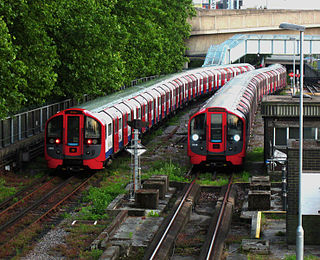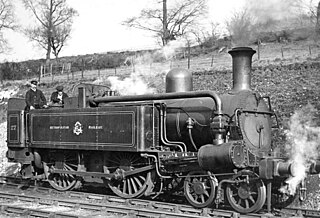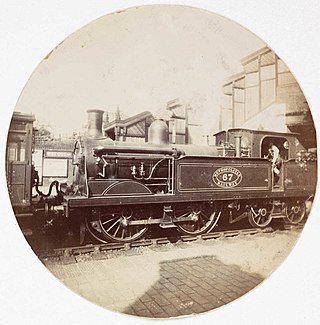
The Metropolitan line, colloquially known as the Met, is a London Underground line between Aldgate in the City of London and Amersham and Chesham in Buckinghamshire, with branches to Watford in Hertfordshire and Uxbridge in Hillingdon. Printed in magenta on the tube map, the line is 41.4 miles (66.7 km) in length and serves 34 stations. Between Aldgate and Finchley Road, the track is mostly in shallow "cut and cover" tunnels, apart from short sections at Barbican and Farringdon stations. The rest of the line is above ground, with a loading gauge of a similar size to those on main lines. Just under 94 million passenger journeys were made on the line in 2019.

The Great Central Railway in England was formed when the Manchester, Sheffield and Lincolnshire Railway changed its name in 1897, anticipating the opening in 1899 of its London Extension. On 1 January 1923, the company was grouped into the London and North Eastern Railway.

The Metropolitan Railway was a passenger and goods railway that served London from 1863 to 1933, its main line heading north-west from the capital's financial heart in the City to what were to become the Middlesex suburbs. Its first line connected the main-line railway termini at Paddington, Euston, and King's Cross to the City. The first section was built beneath the New Road using cut-and-cover between Paddington and King's Cross and in tunnel and cuttings beside Farringdon Road from King's Cross to near Smithfield, near the City. It opened to the public on 10 January 1863 with gas-lit wooden carriages hauled by steam locomotives, the world's first passenger-carrying designated underground railway.

The steam locomotives of British Railways were used by British Railways over the period 1948–1968. The vast majority of these were inherited from its four constituent companies, the "Big Four".

London Underground rolling stock includes the electric multiple-unit trains used on the London Underground. These come in two sizes, smaller deep-level tube trains and larger sub-surface trains of a similar size to those on British main lines, both running on standard gauge tracks. New trains are designed for the maximum number of standing passengers and for speed of access to the cars.
The London and North Eastern Railway (LNER) produced several classes of locomotive, mostly to the designs of Nigel Gresley, characterised by a three-cylinder layout with a parallel boiler and round-topped firebox. It produced the most famous locomotive of its day, 4468 'Mallard', the holder of the world steam locomotive speed record. It also built the world-famous 4472 'Flying Scotsman'. However, its locomotive inheritance was much greater than just the 'A4 Class', it also produced highly successful mixed-traffic and freight designs.

The London and North Eastern Railway (LNER) Class V2 2-6-2 steam locomotives were designed by Sir Nigel Gresley for express mixed traffic work, and built at the LNER shops at Doncaster and Darlington between 1936 and 1944. The best known is the first of the class, 4771 Green Arrow, which is the sole survivor of the class.

The Metropolitan Railway E Class is a class of 0-4-4T steam locomotives. A total of seven locomotives were built between 1896 and 1901 for the Metropolitan Railway: three by the railway at their Neasden Works and four by Hawthorn Leslie and Company in Newcastle upon Tyne.

The Great Central Railway (GCR) Class 9F was a class of 0-6-2T steam locomotive built between 1891 and 1901. From 1923 the locomotives were redesignated Class N5.
The Metropolitan Railway H Class consisted of eight 4-4-4T steam locomotives, numbered 103 to 110. They were built by Kerr, Stuart & Co of Stoke on Trent in 1920 at a cost of £11,575 each. A "notable addition" to the Metropolitan Railway, these locomotives were purchased for the express passenger trains on the mainline between Harrow —the change point from electric locomotives—and Aylesbury or Verney Junction.

The Metropolitan Railway K Class consisted of six 2-6-4T steam locomotives, numbered 111 to 116.

The Metropolitan Railway A Class and B Class were 4-4-0T condensing steam locomotives built for the Metropolitan Railway by Beyer Peacock, first used in 1864. A total of 40 A Class and 26 of the slightly different B Class were delivered by 1885. Used underground, the locomotives condensed their steam, and coke or smokeless coal was burnt to reduce the smoke.

Under the Whyte notation for the classification of steam locomotives, 0-8-4 represents the wheel arrangement of no leading wheels, eight powered and coupled driving wheels on four axles, and four trailing wheels on two axles.

The London and North Eastern Railway (LNER) Thompson Class L1 was a class of 2-6-4T steam locomotives designed by Edward Thompson. The prototype no. 9000 was built in 1945, but the remaining 99 were built under British Railways jurisdiction between 1948–1950. The prototype was well received, however the production batch were not, and all were withdrawn and scrapped between 1960 and 1962.

The Metropolitan Railway C class was a group of four 0-4-4T steam tank locomotives built in 1891 by Neilson and Company. They were to a design by James Stirling, originally the Q class of the South Eastern Railway, and were fitted with condensing apparatus for working in tunnels.
District Railway steam locomotives were used on London's Metropolitan District Railway. When in 1871 the railway needed its own locomotives, they ordered twenty four condensing steam locomotives from Beyer Peacock similar to the A Class locomotives the Metropolitan Railway was using on the route. As they were intended for an underground railway, the locomotives did not have cabs, but had a weatherboard with a bent-back top and the back plate of the bunker was raised to provide protection when running bunker first.
London's Metropolitan Railway (MR) amalgamated with other underground railways, tramway companies and bus operators on 1 July 1933, to form the London Passenger Transport Board (LPTB); the MR became the Board's Metropolitan line.

The SER Q class was a class of 0-4-4T steam locomotives of the South Eastern Railway. The class was designed by James Stirling and introduced in 1881.

The NBR A Class (London and North Eastern Railway Classes N14 and N15 were the standard 0-6-2 tank locomotives designed by William P. Reid for freight duties on the North British Railway. The LNER regarded the original locomotives as two separate classes. The final batch of locomotives was on order at the time of the grouping in 1923.

The London Underground opened in 1863 with gas-lit wooden carriages hauled by steam locomotives. The Metropolitan and District railways both used carriages exclusively until they electrified in the early 20th century. The District railway replaced all its carriages for electric multiple units, whereas the Metropolitan still used carriages on the outer suburban routes where an electric locomotive at the Baker Street end was exchanged for a steam locomotive en route.
















